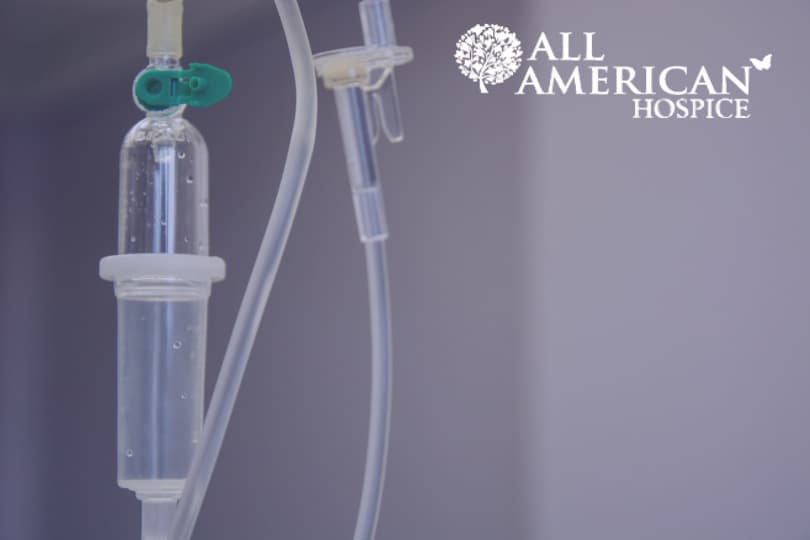Table of Contents

End-stage liver disease (ESLD) encompasses advanced liver disease, liver failure, and decompensated cirrhosis (an advanced stage of cirrhosis). End-stage liver failure is caused by liver inflammation, which results in fibrosis (scarring) and a lack of normal liver function.
Although liver transplantation is the only treatment for ESLD, many patients do not receive one due to extensive waiting lists or other health issues that make them too sick to survive the surgery.
Common Symptoms of ESLD
Symptom management for decompensated liver disease should be done with an interdisciplinary health care team because symptoms may be worsened. Below we will examine what happens when your liver fails.
End-stage liver disease symptoms and signs include:
- Pain in the abdomen
- Fatigue
- Confusion
- Pruritus (a type of itchiness)
- Jaundice (yellowing of the skin and eyes due to the buildup of bile)
- Muscle spasms
- Leg edema (when the legs become swollen)
- Dyspnea (a condition where a person has difficulty breathing)
- Vomiting and nausea
- Constipation
- Diarrhea
- Malnutrition
How Are the Symptoms of ESLD Handled?
Here are five common ESLD symptoms:
- Pain: Medications may be used to manage pain at the end of life, but the right treatment for each person with ESLD may be different. Please talk to your doctor about what kind of medicine will be best suited and how much to take. Acupuncture and mindfulness are two additional ways to deal with pain.
- Ascites: Patients are frequently advised to follow a low-salt diet and take oral diuretics (medicines that assist the body to expel water, such as spironolactone or furosemide). If neither of these approaches works, the fluid in the abdomen can be drained surgically or with a needle.
- Hepatic encephalopathy: For people dying of liver failure, laxatives and antibiotics are used to help protect brain function by reducing the buildup of toxins in the blood that are bad for the brain.
- Itchiness: Cholestyramine, a common drug, is used to help with itching. Many people think that cholestyramine helps the body get rid of chemicals through the stool, but they don’t know how this works.
- Malnutrition: The treatment process for near-death liver failure patients is physically draining. It is recommended that people consume enough calories, especially from protein, and take vitamins.
About Life Expectancy
The life expectancy of someone with liver cirrhosis is hard to figure out because it’s affected by many factors, including how bad the liver disease is and whether there are other illnesses or comorbidities. People with ESLD don’t know when the disease will worsen or how long they will live.
Some symptoms, like ascites that don’t respond to treatment, kidney failure, and gastrointestinal bleeding, have been linked to worsening disease and shortened lives. People with advanced cirrhosis have an average life expectancy of two years.
The Model for End-Stage Liver Disease (MELD) predicts what will happen to people with the condition in the long run. The MELD score is based on lab results and ranks people who need a liver transplant.
Is It Time for Professional Care?
Due to the patient’s slow deterioration, it’s hard to tell whether they’re ready for hospice care. Most hospice patients live for six months or less. Liver transplants are not for everyone, and in difficult-to-control symptoms, patients, families, and doctors usually consider a hospice.
Keep a watch out for the telltale signs that the illness has progressed to the point where hospice care may benefit. Don’t delay decision-making when your loved one is at risk of death from liver failure.
How Do Professionals Care for ESLD?
As the symptoms and conditions change towards the death stages of liver cirrhosis, the hospice team looks at the patient’s health and changes the care plans, sometimes every day. The goal of hospice care is to control symptoms and ease physical and mental pain so that patients can maintain their dignity and comfort.
A hospice offers a lot of help to people with ESLD:
- Symptom management entails assisting people with ESLD with respiratory and gastrointestinal issues, itchy skin, abdominal discomfort, restlessness, confusion, and other symptoms.
- People near death may not be able to say what they want. They need a personalized care plan to ensure they get what they need. Pain, hydration, nourishment, skincare, agitation, bleeding, and other symptoms linked to the diagnosis will all be looked at by a doctor.
- Those in need of assistance are cared for at home, nursing homes, or assisted living complexes. Inpatient hospice treatments are available for those who need 24-hour care.
- The patient’s gastroenterologist or other doctor helps and approves the care plan. This is referred to as “organized care.” A team manager ensures that doctors, nurses, social workers, and, if desired, clergy interact. A hospice also ensures that patients receive all necessary medications, medical supplies, and equipment.
- A hospice has the resources to assist patients in maintaining emotional and spiritual wellness.
- Reduced likelihood of readmission to hospital: some terminally sick patients visit the ER frequently, while others are often hospitalized. Hospice care minimizes readmissions.
- Security. Uncertainty about getting medical help when you need it is one of the most important hospice benefits. Having 24-hour access to healthcare is a blessing. Hospice programs also educate, equip, and support families in providing the best care for their sick loved ones.
Conclusion
Early palliative care referrals are indicated because the course of ESLD is unpredictable due to periods of improvement and worsening symptoms. Palliative care attempts to improve the quality of life for persons with terminal illnesses by offering comfort, dignity, and pain relief. When the time comes, your doctor may recommend hospice care.
As anyone who has suffered from a significant illness knows, patients and family members must frequently act as advocates to ensure the care they require and deserve. We are eager to provide you and your family with the best treatment and support!

 215-322-5256
215-322-5256
Comments are closed.